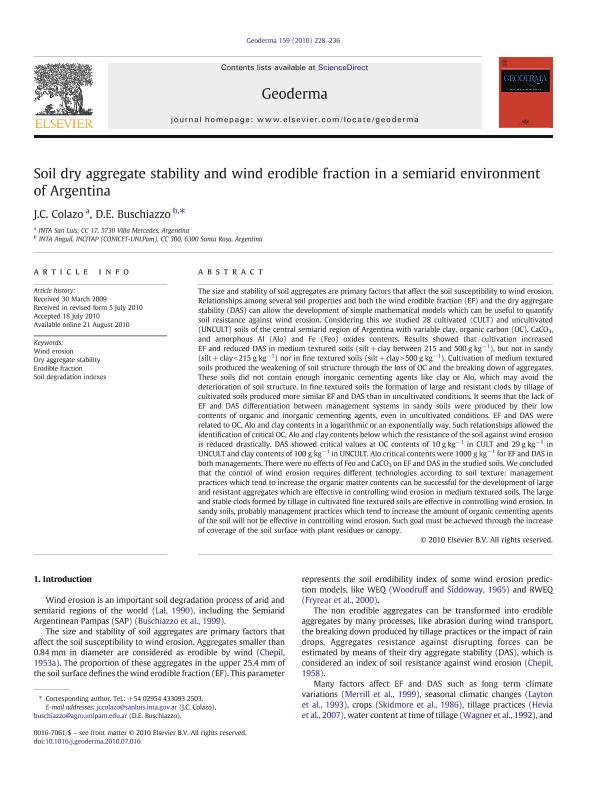Mostrar el registro sencillo del ítem
dc.contributor.author
Colazo, Juan Cruz

dc.contributor.author
Buschiazzo, Daniel Eduardo

dc.date.available
2019-08-14T18:01:53Z
dc.date.issued
2010-10
dc.identifier.citation
Colazo, Juan Cruz; Buschiazzo, Daniel Eduardo; Soil dry aggregate stability and wind erodible fraction in a semiarid environment of Argentina; Elsevier Science; Geoderma; 159; 1-2; 10-2010; 228-236
dc.identifier.issn
0016-7061
dc.identifier.uri
http://hdl.handle.net/11336/81598
dc.description.abstract
The size and stability of soil aggregates are primary factors that affect the soil susceptibility to wind erosion. Relationships among several soil properties and both the wind erodible fraction (EF) and the dry aggregate stability (DAS) can allow the development of simple mathematical models which can be useful to quantify soil resistance against wind erosion. Considering this we studied 28 cultivated (CULT) and uncultivated (UNCULT) soils of the central semiarid region of Argentina with variable clay, organic carbon (OC), CaCO3, and amorphous Al (Alo) and Fe (Feo) oxides contents. Results showed that cultivation increased EF and reduced DAS in medium textured soils (silt+clay between 215 and 500gkg-1), but not in sandy (silt+clay<215gkg-1) nor in fine textured soils (silt+clay>500gkg-1). Cultivation of medium textured soils produced the weakening of soil structure through the loss of OC and the breaking down of aggregates. These soils did not contain enough inorganic cementing agents like clay or Alo, which may avoid the deterioration of soil structure. In fine textured soils the formation of large and resistant clods by tillage of cultivated soils produced more similar EF and DAS than in uncultivated conditions. It seems that the lack of EF and DAS differentiation between management systems in sandy soils were produced by their low contents of organic and inorganic cementing agents, even in uncultivated conditions. EF and DAS were related to OC, Alo and clay contents in a logarithmic or an exponentially way. Such relationships allowed the identification of critical OC, Alo and clay contents below which the resistance of the soil against wind erosion is reduced drastically. DAS showed critical values at OC contents of 10gkg-1 in CULT and 29gkg-1 in UNCULT and clay contents of 100gkg-1 in UNCULT. Alo critical contents were 1000gkg-1 for EF and DAS in both managements. There were no effects of Feo and CaCO3 on EF and DAS in the studied soils. We concluded that the control of wind erosion requires different technologies according to soil texture: management practices which tend to increase the organic matter contents can be successful for the development of large and resistant aggregates which are effective in controlling wind erosion in medium textured soils. The large and stable clods formed by tillage in cultivated fine textured soils are effective in controlling wind erosion. In sandy soils, probably management practices which tend to increase the amount of organic cementing agents of the soil will not be effective in controlling wind erosion. Such goal must be achieved through the increase of coverage of the soil surface with plant residues or canopy.
dc.format
application/pdf
dc.language.iso
eng
dc.publisher
Elsevier Science

dc.rights
info:eu-repo/semantics/openAccess
dc.rights.uri
https://creativecommons.org/licenses/by-nc-sa/2.5/ar/
dc.subject
Dry Aggregate Stability
dc.subject
Erodible Fraction
dc.subject
Soil Degradation Indexes
dc.subject
Wind Erosion
dc.subject.classification
Otras Ciencias Agrícolas

dc.subject.classification
Otras Ciencias Agrícolas

dc.subject.classification
CIENCIAS AGRÍCOLAS

dc.title
Soil dry aggregate stability and wind erodible fraction in a semiarid environment of Argentina
dc.type
info:eu-repo/semantics/article
dc.type
info:ar-repo/semantics/artículo
dc.type
info:eu-repo/semantics/publishedVersion
dc.date.updated
2019-08-13T19:13:28Z
dc.journal.volume
159
dc.journal.number
1-2
dc.journal.pagination
228-236
dc.journal.pais
Países Bajos

dc.journal.ciudad
Amsterdam
dc.description.fil
Fil: Colazo, Juan Cruz. Instituto Nacional de Tecnología Agropecuaria. Centro Regional La Pampa-San Luis; Argentina
dc.description.fil
Fil: Buschiazzo, Daniel Eduardo. Consejo Nacional de Investigaciones Científicas y Técnicas. Instituto de Ciencias de la Tierra y Ambientales de La Pampa. Universidad Nacional de La Pampa. Facultad de Ciencias Exactas y Naturales. Instituto de Ciencias de la Tierra y Ambientales de La Pampa; Argentina. Instituto Nacional de Tecnología Agropecuaria. Centro Regional La Pampa-San Luis. Estación Experimental Agropecuaria Anguil; Argentina
dc.journal.title
Geoderma

dc.relation.alternativeid
info:eu-repo/semantics/altIdentifier/url/https://www.sciencedirect.com/science/article/pii/S0016706110002272
dc.relation.alternativeid
info:eu-repo/semantics/altIdentifier/doi/https://doi.org/10.1016/j.geoderma.2010.07.016
Archivos asociados
